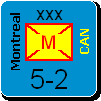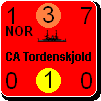warspite1
Posts: 41353
Joined: 2/2/2008
From: England
Status: offline

|
quote:
ORIGINAL: terje439
from JGN
quote:
ORIGINAL: Empire 101
What was the name of the commander who sunk the Royal Oak at Scapa Flow, and what was the name/designation of his vessel?
Sinking of HMS Royal Oak
U-47 became famous when, on October 14, 1939, under the command of Günther Prien, she managed to enter the base of the British home fleet at Scapa Flow through a hole in the defence line, and sank the battleship HMS Royal Oak, which was in Scapa Flow in a largely unprepared state, although World War II had recently begun.
quote:
ORIGINAL: Empire 101
What was the name of the US gunboat sunk by the Japanese in 1937?
On December 12, 1937 Japanese naval aircraft were ordered by their Army to attack “any and all ships” in the Yangtze above Nanking. Knowing of the presence of Panay and the merchantmen, the Imperial Japanese Navy requested verification of the order, which was received before the attack began about 13:27 that day. Although there were several large American flags flown on the ship, as well as one painted atop the cabin, the Japanese planes continued strafing and bombing the area around the Panay. Panay was hit by two of the eighteen 60-kg (132 pound) bombs dropped by three Yokosuka B4Y Type-96 bombers and strafed by nine Nakajima A4N Type-95 fighters. The bombing continued until Panay sank at 15:54. Three sailors were killed, and 43 sailors and 5 civilian passengers wounded.
quote:
ORIGINAL: Empire 101
What was the name of the infamous Japanese commander in charge of units that committed the worst pre WWII atrocity at Nanking?
The Japanese awaited an answer. When no Chinese envoy had arrived by 1:00 p.m. the following day, General Matsui Iwane issued the command to take Nanking by force. On December 12, 2937 after two days of Japanese attack, under heavy artillery fire and aerial bombardment, General Tang Sheng-chi ordered his men to retreat. What followed was nothing short of chaos. Some Chinese soldiers stripped civilians of their clothing in a desperate attempt to blend in, and many others were shot in the back by their own comrades as they tried to flee. Those who actually made it outside the city walls fled north to the Yangtze, only to find that there were no vessels remaining to take them. Some then jumped into the wintry waters and drowned.
The Japanese entered the walled city of Nanjing on December 13, 1937 and faced little military resistance.
quote:
ORIGINAL: Empire 101
What ship fired the last three torpedoes at the Scharnhorst at the Battle of the Barents Sea?
This must be a trick question, because the Scharnhorst was not at "the Battle of the Barents Sea".
the Battle of the Barents Sea
Commonwealth Order of battle:
Fourteen merchant ships guarded by the destroyers HMS Achates, Orwell, Oribi, Onslow, Obedient, and Obdurate; the Flower class corvettes Rhododendron and Hyderabad; the minesweeper HMS Bramble; and two trawlers Vizalma and Northern Gem.
"Force R" independently stationed in the Barents Sea - the cruisers Sheffield, Jamaica, and two destroyers.
German Order of battle:
The heavy cruiser Admiral Hipper; pocket battleship Lützow; and destroyers Friedrich Eckholdt, Richard Beitzen, Theodor Riedel, Z 29, Z 30, and Z 31.
However, at “the Battle of North Cape”…
On Christmas Day 1943, Scharnhorst and several destroyers, under the command of Konteradmiral (Rear Admiral) Erich Bey, put to sea with the purpose of attacking the Russia-bound Arctic convoys JW 55B and RA 55A north of Norway. Unfortunately for the Germans, their orders had been decoded by the British code breakers and the Admiralty were able to direct their forces to intercept. The next day, in heavy weather and unable to locate the convoy, Bey detached the destroyers and sent them south, leaving Scharnhorst alone. Less than two hours later, the ship encountered the convoy's escort force of the cruisers HMS Belfast, Norfolk, and Sheffield. Belfast had picked up Scharnhorst at 08:40 and 35,000 yards (32,000 m) using her Type 273 radar and by 09:41, Sheffield had made visual contact. Under cover of snow, the British cruisers opened fire. Belfast attempted to illuminate Scharnhorst with starshell, but was unsuccessful. Norfolk, however, opened fire using her radar to spot the fall of shot and scored two hits. One of these demolished Scharnhorst's main radar aerial, disabling the set and leaving her unable to return accurate fire in low visibility. Norfolk suffered minor damage.
In order to try to get around the cruisers to the convoy, Bey ordered Scharnhorst to take a southeast course away from the cruisers. In the late afternoon, the convoy's covering force, including the British battleship HMS Duke of York, made contact and opened fire. Despite suffering the loss of its hangar and a turret, Scharnhorst temporarily increased its distance from its pursuers. The Duke of York caught up again and fired again - the second salvo wrecked the "A" turret, detonating the charges in "A" magazine which led to the same in "B" magazine. Partial flooding of the magazines quenched the explosions. No Royal Navy ship received any serious damage, though the flagship was frequently straddled, and one of her masts was smashed by an 11-inch (280 mm) shell. At 18:00 Scharnhorst's main battery went silent; at 18:20 another round from Duke of York destroyed a boiler room, reducing Scharnhorst's speed to about 22 knots (41 km/h) and leaving her open to attacks from the destroyers. Duke of York fired her 77th salvo at 19:28.
Battered and crippled as she was, her secondary armament was still firing wildly as the cruiser HMS Jamaica and the destroyers Musketeer, Matchless, Opportune, and Virago closed and launched torpedoes at 19:32. The last three torpedoes, fired by Jamaica at 19:37 from under two miles (3 km) range, were the final crippling blows.
A total of 55 torpedoes and 2,195 shells had been fired at Scharnhorst.
Warspite1
I thought we weren`t looking up the answers??
|
 Printable Version
Printable Version


















 In which case I will go for the French Richelieu (15-inch) or Dunkerque (12 or 13-inchers)
In which case I will go for the French Richelieu (15-inch) or Dunkerque (12 or 13-inchers) 

 New Messages
New Messages No New Messages
No New Messages Hot Topic w/ New Messages
Hot Topic w/ New Messages Hot Topic w/o New Messages
Hot Topic w/o New Messages Locked w/ New Messages
Locked w/ New Messages Locked w/o New Messages
Locked w/o New Messages Post New Thread
Post New Thread